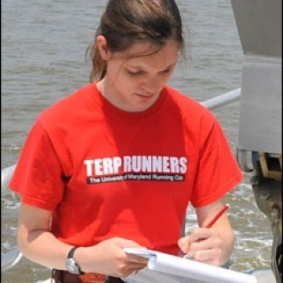Eight students will be presenting the summer work at the Ocean Sciences Meeting in March 2022!
Hilary Staver, University of Maryland, College Park
Class Year:
2011Mentor:
Lora Harris, Ph.D.Project Title:
Picophytoplankton Biomass and Productivity in the Potomac and Patuxent Rivers
Abstract:
Picoplankton are plankton between 0.2 and 2.0 μm in diameter. Chlorophyll analyses are traditionally conducted using glass-mesh fiber filters (GF/Fs) with a nominal pore size of 0.7 μm, so chlorophyll measurements can be biased if picophytoplankton slip through the GF/F filter and are not counted. For this study, fourteen sites on the Potomac and Patuxent Rivers were sampled to determine what proportion of total planktonic biomass and primary productivity is accounted for by picophytoplankton that slip through GF/F filters. Water samples were filtered sequentially through a GF/F filter pad and then a polycarbonate filter membrane with 0.2-μm pores, isolating picoplankton between 0.7 and 0.2 μm on the polycarbonate membrane. Both filters were then analyzed for chlorophyll-a concentration, and light-dark oxygen evolution incubations were performed on both whole water samples and the GF/F filtrate. Picophytoplankton trapped on the polycarbonate filter were found to account for an average of 0.241% of total planktonic chlorophyll and 0.1% of modeled total planktonic primary productivity. These results suggest that picophytoplankton that are missed by GF/F filters are not significant contributors to planktonic biomass or primary productivity in these locations during the months when sampling occurred.



